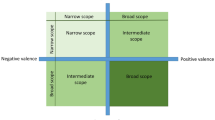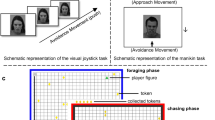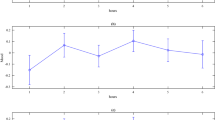Abstract
IN 1940 Tinbergen1 and Kortlandt2 independently drew attention to a behavioural phenomenon which has since been called displacement activity and has received a good deal of attention3,4. Although no binding rules exist by which displacement behaviour can be recognized, the term is applied to behaviour patterns which appear to be out of context with the behaviour which closely precedes or follows them, either in the sense that they do not seem functionally integrated with the preceding or following behaviour or that they occur in situations in which causal factors usually responsible for them appear to be absent or at least weak compared with those determining the behavioural envelope. Displacement activities occur in three situations: motivational conflict, frustration of consummatory acts and physical thwarting of performance. Several theories have been put forward to explain the causal mechanism involved5–8. A variety of behaviour patterns have been reported as displacement activities9, even in a single species, but this variety needs revision10. Monographic treatments of the behaviour of any one species usually indicate only two or three activities which according to the judgment of the observer occur commonly as displacement. None of the theories on displacement activities gives cogent reasons why particular behaviour patterns should be more common than others as displacement activities, apart from stating that the causal agents which usually elicit them in non-displacement situations can also be presumed to be present, if only weakly, in the displacement context, or remarking that these patterns are prepotent in the repertoire of the animal.
This is a preview of subscription content, access via your institution
Access options
Subscribe to this journal
Receive 51 print issues and online access
$199.00 per year
only $3.90 per issue
Buy this article
- Purchase on Springer Link
- Instant access to full article PDF
Prices may be subject to local taxes which are calculated during checkout
Similar content being viewed by others
References
Tinbergen, N., Z. Tierpsychol., 4, 1 (1940).
Kortlandt, A., Arch. Neerl. Zool., 4, 442 (1940).
Zeigler, H. P., Psychol. Bull., 61, 362 (1964).
Hinde, R. A., Animal Behaviour (McGraw-Hill, 1966).
Tinbergen, N., The Study of Instinct (Oxford University Press, 1951).
Bindra, D., Brit. J. Psychol., 50, 263 (1959).
Sevenster, P., Behaviour, suppl. 9 (1961).
McFarland, D. J., Z. Tierpsychol., 23, 217 (1966).
Tinbergen, N., Quart. Rev. Biol., 27, 1 (1952).
Beer, C. G., Behaviour, 18, 62 (1961).
Delius, J. D., J. Small Anim. Pract., 7, 605 (1966).
Delius, J. D., Med. Biol. Eng., 4, 393 (1966).
Tinbergen, N., Behaviour, 15, 1 (1959).
Goethe, F., Behaviour, 11, 310 (1957).
Parmeggiani, P. L., Helv. Physiol. Pharmacol. Acta, 20, 347 (1962).
Rowland, V., and Gluck, H., Rec. Adv. Biol. Psychiat. (edit. by Wortis, J.), 96 (Grune and Stratton, 1960).
Leyhausen, P., Z. Tierpsychol., suppl. 2 (1956).
Caspers, H., Brain Function (edit. by Brazier, M. A. B.), 177 (University of California Press, 1963).
Grant, E. C., Behaviour, 21, 260 (1963).
Bindra, D., Motivation, a Systematic Reinterpretation (Ronald Press, 1959).
Johnson, H. J., Decision Making, Conflict and Physiological Arousal (PhD thesis, Illinois, 1962).
Berlyne, D. E., Conflict, Arousal and Curiosity (McGraw-Hill, 1960).
Welford, A. T., Nature, 194, 365 (1962).
Broadbent, D. E., Brit. J. Math. Stat. Psychol., 18, 145 (1965).
Hutt, C., and S. J., Lee, D., and Ounsted, C., Nature, 204, 908 (1964).
Delgado, J. M. R., Intern. Rev. Neurobiol., 6, 349 (1964).
Freeman, G. L., Psychol. Rev., 47, 491 (1940).
Chance, M. R. A., Symp. Zool. Soc. Lond., 8, 71 (1962).
Gastaut, H., and Bert, J., The Nature of Sleep (edit. by Wolstenholme, G. E. W., and O'Connor, M.), 260 (Churchill, 1961).
Pompeiano, O., Aspects anatomo-fonctionels de la physiologie du sommeil, 309 (C. N. R. S. 1965).
Author information
Authors and Affiliations
Rights and permissions
About this article
Cite this article
DELIUS, J. Displacement Activities and Arousal. Nature 214, 1259–1260 (1967). https://doi.org/10.1038/2141259a0
Received:
Issue Date:
DOI: https://doi.org/10.1038/2141259a0
This article is cited by
-
Appeasement function of displacement behaviours? Dogs’ behavioural displays exhibited towards threatening and neutral humans
Animal Cognition (2023)
-
Audience effect on domestic dogs’ behavioural displays and facial expressions
Scientific Reports (2022)
-
Smell facilitates auditory contagious yawning in stranger rats
Animal Cognition (2015)
-
Monitoring, indicators and community based forest management in the tropics: pretexts or red herrings?
Biodiversity and Conservation (2008)
-
Yawning: An evolutionary perspective
Human Evolution (1999)
Comments
By submitting a comment you agree to abide by our Terms and Community Guidelines. If you find something abusive or that does not comply with our terms or guidelines please flag it as inappropriate.



